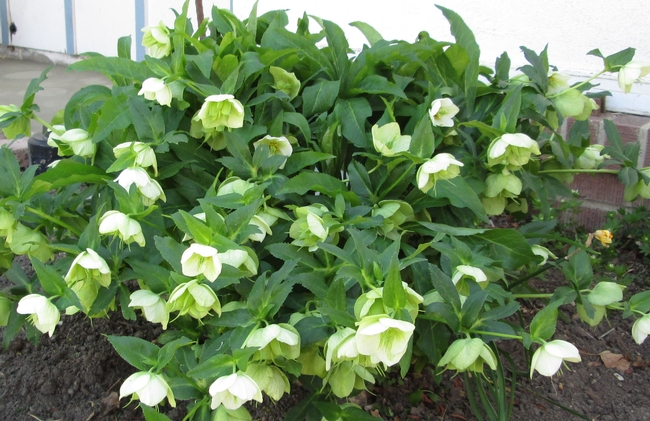Hellebores, with their neat mounds of evergreen foliage and showy flowers in early spring are hard to beat as plants to cheer up shady spots under trees or on the north side of a house. They are members of the Ranunculaceae family and are generally native to southern and eastern Europe. Clumps of handsome leaves about 12 inches high produce many stems of nodding flowers early in the year. These are rather similar in shape to a cupped wild rose, but close inspection shows that what appears to be petals are in fact sepals. As is often the case where sepals are the showy part of the plant, this has the advantage of giving a prolonged blooming season with the “flowers” staying in good shape for several weeks. The mainly green or white colors of the wild plants have been improved by hybridization and now include a vast array of pinks, slate gray, maroon, spotted and picoteed, but they generally revert to green as they age. Double flowered varieties have also been introduced. Although they are poisonous to humans and animals they all have productive nectaries and are beloved by bees which will visit in large numbers on warm days.
Unlike most shade-loving plants, hellebores prefer a slightly alkaline soil in order to thrive. They do require regular irrigation and a mulch of leaf mold to help retain moisture is beneficial although large clumps can tolerate occasional drying out. The clumps are tightly formed, so they do not invade their surroundings but they resent disturbance once established so a mature plant will often take a couple of years to recover if it is moved (that is, presuming it survives). Likewise it is almost impossible to split a mature clump successfully. However, they frequently seed in large numbers around the parent plant, and it is a simple matter to dig up and transplant the seedlings, but of course the hybrids will not be the same as the parent in color or form.
Hellebores are not touched by deer or rodents, and are renowned for being pest-free; however, in my garden H. orienalis has had a quite serious aphid infestation in just the past two years, perhaps due to the mild winters.
Helleborus orientalis and its hybrids (sometimes described as H.x hybridus) need some winter chill and comfortably grow in Zones 6 and up. They have the widest selection of colors and are probably the most commonly grown and, therefore, most likely to be found in local nurseries. This species is often called the “Lenten rose” (although, of course it is not related to roses) and in my Bishop garden it generally produces a generous crop of 2 inch, white, cupped flowers between March and April. It happily grows as a large clump of dark green leaves on the north side of the house which is mostly in the shade, but between the equinoxes it does get a blast of afternoon sun which sometimes burns the leaves.
Helleborus niger or "Christmas rose" is winter hardy to zone 4 and is lower growing and produces glistening white flowers with yellow stamens in mid-winter. Variety 'Potter's Wheel' has larger flowers than the species and is much sought after, but it is hard to propagate. There are also pink and double flowered varieties. This must have alkaline soil, be protected from strong direct sun, and have a reliably moist soil.
Helleborus argutifolius or Corsican Hellebore grows in Zones 6-9, has coarse, blue-green toothed foliage and clusters of green nodding 2” flowers held on 2ft-3ft long stalks which have a tendency to sprawl. It can become almost shrub-like. Although more sun tolerant, it is not as hardy as the previous two species but has grown under heavy shade on a west-facing wall in Bishop for 6 years without mishap.
Helleborus foetidus or the Stinking Hellebore, is often grown more for its foliage than its flowers. Clusters of small, bright green flowers on long stems arise from clumps of handsome, evergreen foliage. Newer hybrids have been bred to produce interesting foliage such as finely divided leaves or bronze coloring. The plant is hardy to Zone 5, although the flowers will be damaged in those temperatures.
To see a sample of the huge variety of flowers available check out some of the specialist nurseries such as:
